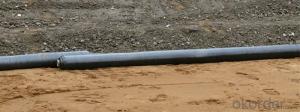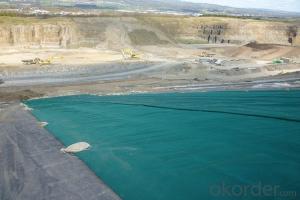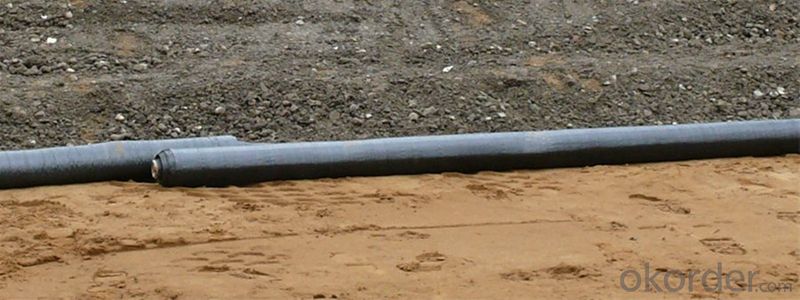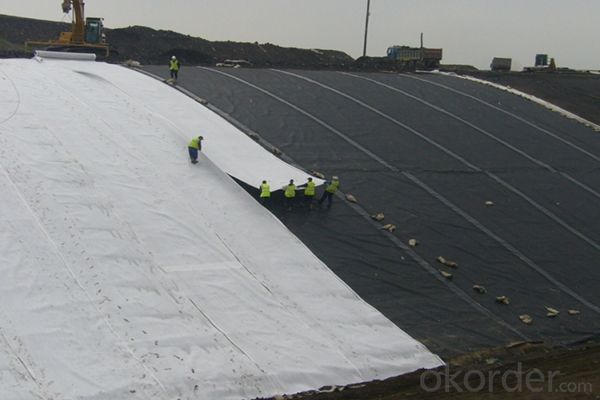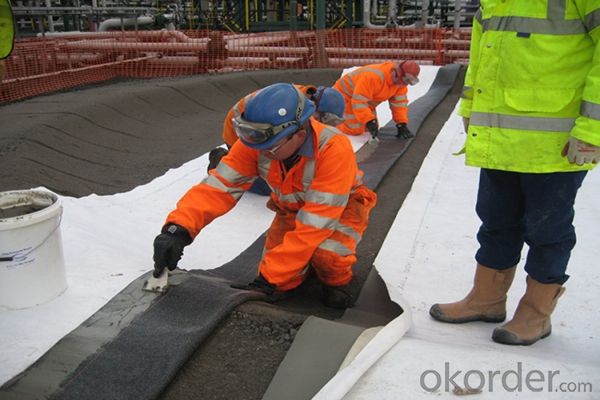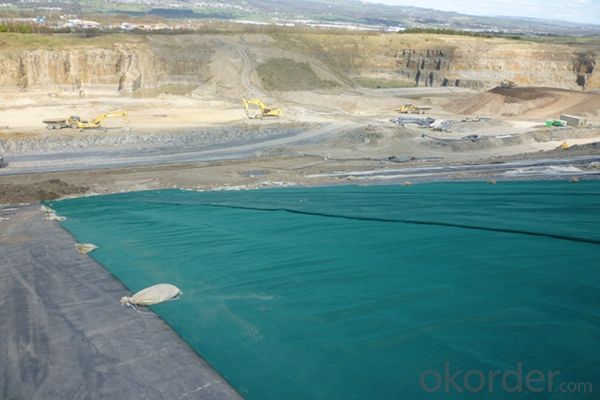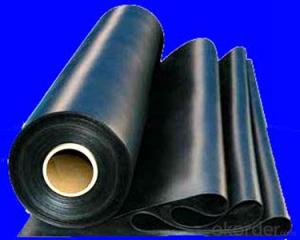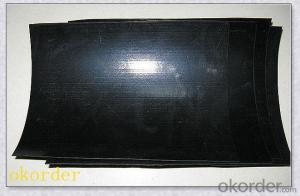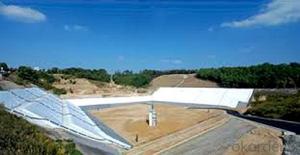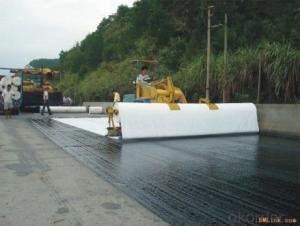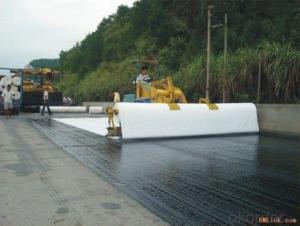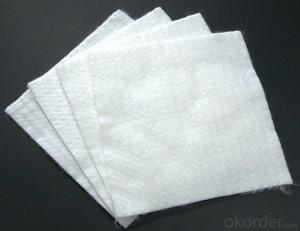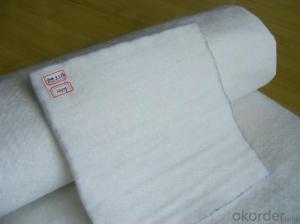Geotextil Bricomart Polyethylene HDPE Waterproofing Geomembrane High Quality Liner
- Loading Port:
- China main port
- Payment Terms:
- TT OR LC
- Min Order Qty:
- 1000 m²
- Supply Capability:
- 1000000 m²/month
OKorder Service Pledge
OKorder Financial Service
You Might Also Like

Product Introduction
Material: HDPE, LDPE
Thickness: 1mm-3mm
Width:4m-9m
Quality Inspection Standard: GB/T17643-1998
Quality Control Measure: strictly comply with ISO9001:2000
Have passed the CE certificate in Sep. 2008.
Features:
1) Can bear chemical erosion.
2) A wider using temperature range and a longer using life.
Geomembrane is produced from virgin high-density polyethylene (HDPE) or linear polyethylene (LLDPE) of highest quality with the addition of a concentrate of carbon black, which is a powerful UV-absorber that protects material from destruction. The use of various stabilizing additives allows produce more elastic, durable and resistant to external negative factors geomembrane.
The formation of geomembrane sheets occurs by extrusion with subsequent cooling in 3-shaft calender, which allows to produce a homogeneous and uniform cloth. Geomembrane is produced with a thickness from 0.5 to 4 mm.
Applications
Solid Waste Landfill for secured dumping of Hazardous Waste.
Lining of Fly Ash ponds.
Thermal / Hydro power plant.
Dumping of Radio Active waste.
Masking of concrete structures at places like Port, Jetty, Bridge.
Spill containment for Chemical and Petrochemical Industries.
Industrial Reservoirs
Lining of ETPs
Lining of Solar Evaporation Ponds / Sludge Ponds etc..
Foundation Lining, Floor Lining
Our Service
Quality assurance
1.On a regular basis or as per your request,we entrust national testing agencies to conduct quality inspections
2. Strictly in accordance with the ISO9001-2008 international quality system standard,we monitor and manage the whole process throughout production,quality testing,and measurement to ensure product quality
3. For quality-related construction delay or substandard construction(except for damage or losses due to customer’s responsibility or irresistible natural disasters),we have refunding,replacement,and repair services.We will respond to customers’ feedbacks on quality issues within 24 hours.
Packaging & Shipping
Packing: PLASTIC FILM INSIDE, AND WOVEN BAG OUTSIDE
Shipping: About 15 days after receipt the deposit
FAQ:
Q: What kind of payments does jenor support?
A: T/T, L/C, Cash are accepted.
Q: Do you charge for the samples?
A: Accordeing to our company policy, the samples are free, we only charge the freight fee. And we will return the freight fee during the next order.
Q: Can you produce according to customers' design?
A: Sure, we are professional manufacturer, OEM and ODM are both welcome.
Q: Do you have other products?
A: Yes, please check the pictures:
- Q: How do geotextiles help with separation and stabilization in railroads?
- Geotextiles are used in railroads to effectively separate and stabilize different layers of the track system. By providing a strong barrier between the subsoil and the ballast layer, geotextiles prevent the mixing of materials and maintain the integrity of the track structure. This separation helps to evenly distribute loads and prevent differential settlement. Additionally, geotextiles contribute to stabilization by enhancing the overall strength and stiffness of the track system, reducing the potential for deformation and improving the long-term performance of the railroads.
- Q: Can geotextiles be used in the protection of pipelines?
- Yes, geotextiles can be used in the protection of pipelines. Geotextiles are commonly employed as a protective layer to prevent damage to pipelines caused by external factors such as soil erosion, chemical exposure, and mechanical impacts. They act as a barrier between the pipeline and the surrounding soil, providing cushioning and reducing the risk of abrasion or puncture. Geotextiles also help to distribute the loads and stresses evenly, enhancing the overall stability and longevity of the pipeline system.
- Q: Can geotextiles be used for reinforcement in landfills?
- Yes, geotextiles can be used for reinforcement in landfills. Geotextiles are commonly used as a geosynthetic material in landfill construction and operation. They are placed within the landfill to improve stability, prevent soil erosion, and enhance the overall strength of the landfill structure. Additionally, geotextiles help to control water flow and filter out contaminants, providing an effective solution for reinforcement in landfills.
- Q: PET geotextile is what?
- PET for the polyester on behalf of the name, PET geotextile is also divided into many kinds, such as: broken geotextile, filament geotextile, filament weaving, etc., I understand only these. Look at what you mean.
- Q: Are geotextiles effective in preventing weed growth?
- Yes, geotextiles are effective in preventing weed growth. They act as a physical barrier that inhibits weed growth by blocking sunlight and preventing weed seeds from germinating. Additionally, geotextiles allow for water and air permeability, ensuring proper drainage while still suppressing weed growth.
- Q: What are the different geotextile specifications and standards?
- There are several different geotextile specifications and standards that are commonly used in the industry. Some of the most widely recognized specifications include ASTM D35, ISO 10318, and EN 13249. These standards outline various requirements for geotextiles, such as strength, permeability, and durability. Additionally, there are specific specifications for different applications, such as road construction, erosion control, and drainage systems. It is important to adhere to these specifications to ensure the proper performance and functionality of geotextile materials in various engineering projects.
- Q: How are geotextiles used in coastal engineering?
- Geotextiles are commonly used in coastal engineering to stabilize and protect coastlines. They are placed beneath coastal structures or along the shoreline to prevent erosion, reduce wave impact, and enhance sedimentation. Geotextiles act as a barrier, preventing the loss of soil while allowing water to pass through, thereby minimizing the negative effects of waves and tides on the coastline. Additionally, they provide a stable foundation for coastal structures like revetments, breakwaters, and seawalls, helping to maintain their integrity and longevity.
- Q: How do geotextiles help in preventing lateral spreading of soil?
- Geotextiles help in preventing lateral spreading of soil by acting as a barrier that stabilizes the soil and restricts its movement. These synthetic materials are placed between layers of soil to provide reinforcement and prevent the lateral displacement of soil particles. The geotextiles act as a separator, allowing water to pass through while retaining soil particles, thus reducing the potential for soil erosion and lateral spreading.
- Q: 300 grams of non-woven geotextile piercing strength is how much
- First of all, according to what you said 300g non-woven geotextile should be polyester staple fiber non-woven geotextile. Polyester staple fiber non - woven geotextile implementation of the national standard GB / T - 2008 standard. According to GB / T-2008 standard anti-puncture strength (standard is CBR burst strength) requirements, 300g national standard geotextile anti-piercing strength should be ≥ 1.5KN.
- Q: How about the geotextile pond
- You said to cover the fish pond, I understand is to build the bottom of the fish pond, but the use is not geotextile, but the composite geomembrane, the film is generally two layers of geotextile in the middle of a layer of geomembrane, , And geomembrane on both sides of the geotextile can prevent the bottom of the sharp objects pierced the geomembrane.
Send your message to us
Geotextil Bricomart Polyethylene HDPE Waterproofing Geomembrane High Quality Liner
- Loading Port:
- China main port
- Payment Terms:
- TT OR LC
- Min Order Qty:
- 1000 m²
- Supply Capability:
- 1000000 m²/month
OKorder Service Pledge
OKorder Financial Service
Similar products
Hot products
Hot Searches
Related keywords
